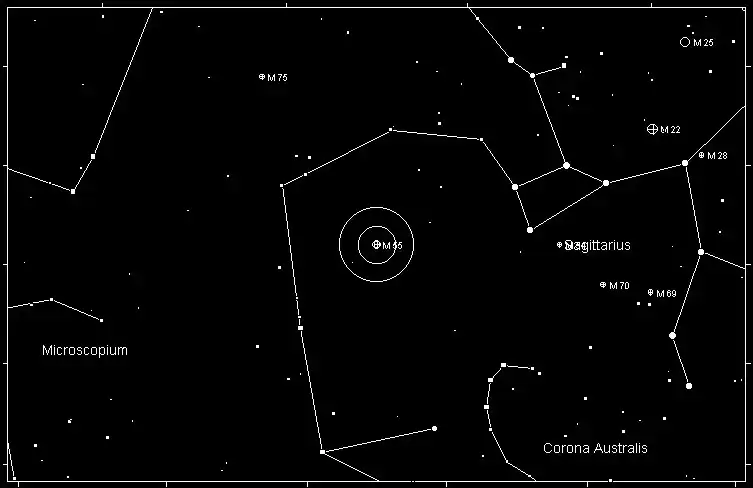Messier 55 (M55), also known as the "Summer Rose Star Cluster," is a globular cluster located in the constellation Sagittarius. Discovered by French astronomer Nicolas-Louis de Lacaille in 1752 and later cataloged by Charles Messier in 1778, M55 is a tightly bound cluster of hundreds of thousands of stars, gravitationally held together. This celestial object is notable for its relatively loose structure and lack of a dense core, making it appear more like an open cluster than a typical globular cluster.
M55 spans approximately 19 arcminutes in diameter, roughly two-thirds the size of the full moon as seen from Earth. The cluster is estimated to be around 17,600 light-years away from our planet and has an actual diameter of about 100 light-years. With an age of over 12 billion years, M55 is one of the ancient residents of our galaxy, orbiting the Milky Way’s core.
Magnitude: Messier 55 has an apparent visual magnitude of 6.3, making it just faint enough to be invisible to the naked eye under average skies but visible through binoculars or a small telescope. Under dark skies, it may be detectable without optical aid, but it is best appreciated through a telescope.

Best Season for Viewing
M55 is best observed during the summer months in the Northern Hemisphere. The ideal window for viewing this cluster stretches from June to September when Sagittarius is prominent in the night sky. During this period, the cluster rises high enough above the horizon for optimal viewing, especially in southern latitudes.
Constellation
Messier 55 is located in the constellation Sagittarius, the Archer. Sagittarius is a rich area of the sky, home to numerous deep-sky objects, including other famous Messier objects like M22, M28, and the Lagoon Nebula (M8). M55 is positioned southeast of the famous "Teapot" asterism within Sagittarius.
How to Find M55
Locating M55 can be challenging for amateur astronomers due to its lack of nearby bright stars as reference points. However, with a good star map and a clear sky, it can be found by first locating the Sagittarius constellation and its prominent "Teapot" shape. The cluster is approximately 7 degrees southeast of the star Zeta Sagittarii (part of the Teapot's handle). Star-hopping from Zeta Sagittarii towards the southeast should eventually bring you to M55.
A low-power eyepiece will reveal M55 as a hazy, diffuse ball of light. Increasing magnification will start to resolve some individual stars within the cluster, though its relatively sparse nature compared to denser globular clusters means you may not see as many stars as you would in clusters like M13 or M22.

History
Messier 55 was first discovered by Nicolas-Louis de Lacaille during his expedition to the Cape of Good Hope in South Africa in 1752. He observed the cluster using a small 12-foot-long telescope and noted it as a nebula. However, it wasn’t until 1778 that Charles Messier, the French astronomer famous for cataloging such objects, added it to his now-famous Messier catalog as M55.
Due to the limitations of telescopes in Messier's time, the individual stars within M55 were not resolved, and the object appeared nebulous, much like other globular clusters. Modern telescopes, however, easily resolve M55 into its constituent stars, revealing its true nature as a densely packed stellar system.
Over the centuries, M55 has been studied extensively, helping astronomers better understand the formation and evolution of globular clusters, as well as the dynamics of the Milky Way’s halo. Its ancient stars, some of which are red giants, provide a glimpse into the early universe, making M55 not only a visually stunning object but also a scientifically valuable one.
Conclusion
Messier 55 is a delightful globular cluster located in the rich constellation of Sagittarius. Though it may be tricky to find for beginners, the effort is well worth it. Whether you're an amateur stargazer or a seasoned astronomer, observing M55 offers a chance to connect with one of the Milky Way's oldest stellar systems. With a telescope and clear summer skies, this cosmic rose can bloom before your eyes, revealing its glittering stars.
